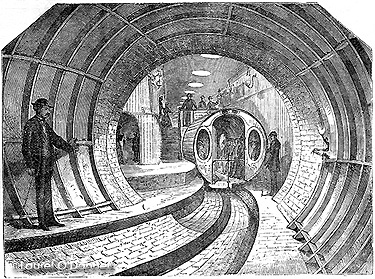|
|
Chapter IV
New York As It Is.
Streets and Avenues A. Description of the Island.—
B. Population at Different Periods.—
C. Streets and Avenues.—
D. Architecture of Manhattan—
E. Business in New York—
F. Churches of New York—
G. Parks and Squares.—
H. How New York is Supplied with Water.—
I. The Schools and Colleges of New York.—
J. Public Security—
K. New York All the Year Round—
L. The Libraries, Monuments and Markets of New York—
M. The Cemeteries of New York.
The Plan, the Pavements, and the Modes of Travel, continued
The Plan, the Pavements, and the Modes of Travel—Wall Street—
Broad Street—
Broadway—
Fifth Avenue—
The Boulevard.
The avenues, from First to Twelfth, numbering from the East river, are designed to be eight miles long (except the Sixth and Seventh, which are cut off by Central Park), are one hundred feet wide (except Lexington and Madison, which are eighty feet), and one thousand feet apart. The cross streets are from one mile to two and a half miles in length, sixty feet wide (except one in ten, which is one hundred), and two hundred and sixty feet apart. The first city railroad was constructed in 1852, and opened with great ceremony, the President of the United States officiating. There are now seventeen lines of horse cars, and numerous omnibus lines, which carry in the aggregate a hundred million passengers annually. These run continuously in all directions, though most of them pass or terminate near the City Hall, which is still the great centre of business attraction. The one hundred and ten monthly magazines, the thirteen daily, arid the two hundred and forty weekly, newspapers are nearly all printed within sight of the City Hall, Park Row and Printing House square producing many of them. The City Hall, the centre of the city government, the Court House, the Hall of Records, the printing, the general Post Office, the principal wholesaling, insurance, and banking houses, being clustered in the lower part of the city, make it the business centre toward which everything still converges. The principal ferries to New Jersey, Staten Island, and Brooklyn make their landings opposite this locality; and opposite this point is now being constructed the lofty East river bridge. Streets in this locality are crowded with cars, carriages, omnibuses, loaded carts, and wagons of every description, from dawn 'till dark, at all seasons of the year, heat and storm but slightly interfering with the busy programme. Bankers, merchants, clerks, agents, in fine, persons of both sexes, and of every age, calling, and country, go rushing by with such rapidity that the modest countryman, though anxious to cross one of these surging thoroughfares, finds himself much in the situation of the rustic in Horace, who stood waiting on the bank for the river to run by. The two principal lines of uptown travel are through Hudson street and Eighth avenue on the west, and Bowery and Third avenue on the east. The elevated railroad, the track laid on iron posts about sixteen feet above the pavement, passes up Greenwich street and Ninth avenue. Various methods for securing rapid transit are being agitated at this time. The plan for the "Pneumatic Tunnel" involves the construction of an underground road, commencing at South Ferry, extending under Broadway to Central Park and above that point, together with a Fourth avenue branch to Harlem river. The company claim that, when the road is completed, they will be able to transport more than twenty thousand persons per hour each way.  The Broadway Pneumatic Underground Railway. View of Car in Motion The "Underground Railroad" proper, is another independent and separate enterprise. |
|
50
:: Previous Page :: Next Page ::
Books & articles appearing here are modified adaptations
from a private collection of vintage books & magazines. Reproduction of these pages is prohibited without written permission. © Laurel O’Donnell, 1996-2006.
|
|